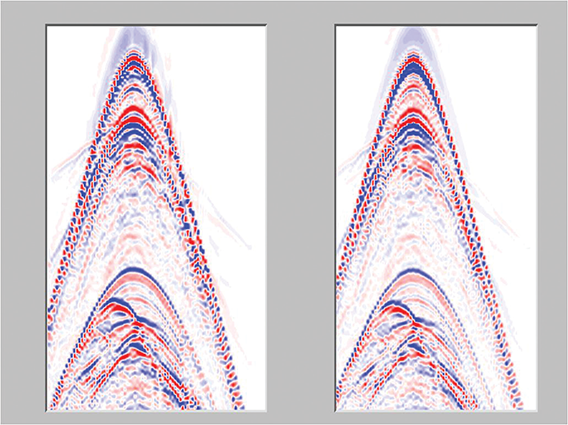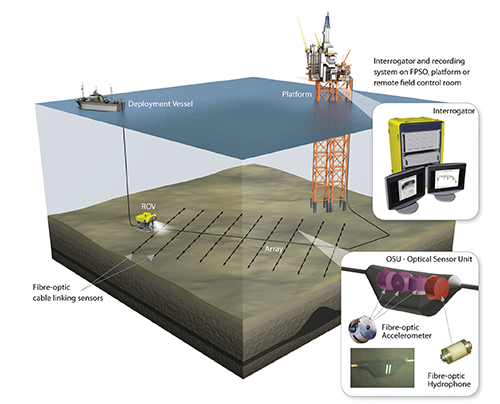
Stingray Geophysical Limited
Sense of achievement
Established in 2006 as a spin-out from QinetiQ, formerly part of the UK Ministry of Defence’s research agency, Stingray Geophysical is fast becoming a key provider of cost-effective and reliable fibre-sensing technology for the offshore oil and gas industry.
Originally developed for anti-submarine warfare applications during the cold war, the core technology has since evolved through a rigorous commercialisation programme and is now being supplied by Stingray as part of a complete solution to help major oilfield operators maximise production and increase total recovery from their reservoirs.
Labelled Fosar®, this fibre-optic seismic permanent reservoir monitoring (Seismic PRM) system uses sensors that can be placed on or buried under the seabed to ensure consistent positioning and optimum coupling, whilst minimising ambient noise and risk of mechanical damage. The sensor array is connected to an interrogation device at the surface that receives and decodes the returning signals when light is pulsed down the fibre. By acquiring highly repeatable time-lapse (4D) imaging data, this technology enables the mapping of fluid movements and pressure changes within the reservoir.
CEO of Stingray, Martin Bett, elaborates on the advantages that Fosar holds over the conventional method of reservoir monitoring: “The conventional way of collecting seismic data would be to tow an array of streamers behind a vessel at specified intervals (repeat streamer 4D). Fosar is a permanent reservoir monitoring system and, once installed, the recurring cost of acquiring new data is considerably lower than using repeat streamer surveys. I like to think of it as the difference between buying a car and using taxis all the time – the car may have a higher capital cost initially, but it will be more cost-effective and convenient in the long term.”

Another benefit of Fosar is its reliability, according to Martin: “The mean time between failures (MTBF) of fibre-optic components is measured in hundreds or even thousands of years, as opposed to electrical components, which are measured in thousands of hours. This makes fibre-optic technology ideal for this sort of application, as the oil field operator wants something that is going to last at least 20 years. Many companies throughout the industry are starting to recognise this and 4D PRM is fast-becoming a multi-billion dollar market.”
The permanent sea bed positioning of the Fosar sensors is also an advantage, as Martin reveals: “In addition to measuring the pressure waves that the conventional repeat streamer 3D technology would pick up, these multi-component sensors are also able to measure shear waves, which are only transmitted through solids. Repeat streamer surveys cannot measure shear waves because they do not travel through the water column to the towed streamers. Fosar solves this problem, providing additional data which allows a better understanding of fluid and pressure effects in the reservoir.
“It is also a considerably quieter environment than towing the sensors behind a boat, and the repeatability of signals at different times means that we can detect smaller changes in the reservoir, again making it easier to understand exactly how the reservoir is evolving and changing as it is produced.”
There are also a number of challenges that must be overcome with such large-scale sensing systems, as Martin explains: “One of the main technical issues was ensuring the fibre-optic system can deliver the fidelity of information that the oil companies require. Fosar is measuring signals in a very large-scale sensing system (typically several tens of thousands of sensors) over very long distances (several hundreds of kilometres). By using a variety of techniques and benefiting from improvements in the lasers that are used to pulse light into the array, we have been able to achieve a signal fidelity that is as good as or even better than conventional electrical sensors but with a much broader bandwidth and dynamic range.
“The challenge was to achieve this while keeping the number of fibres to a minimum. This is particularly important when we need to make subsea connections, as wet-mateable fibre-optic connectors are expensive and can only connect a limited number of fibres in each device, typically eight. This is achieved with a clever optical multiplexing system that underpins the Fosar system, making it reliable and easy to install in subsea environments.”
Stingray has also ensured that Fosar is offered as a complete solution to its customers. Martin continues: “We wanted to make sure that we covered all of the aspects required for Seismic PRM and, up until the installation is completed, it is a subsea engineering project not a seismic operation. We have developed an integrated approach – a process and partners to deliver the complete solution from feasibility studies, front-end engineering design and planning, installation, seismic acquisition and processing so that Seismic PRM can be implemented safely and efficiently by the our clients. We have designed the system for ease of installation in and around platforms or underneath FPSOs. We are also able to offer our customers lease financing so that they can spread the initial cost over several years and avoid a large initial capital cost.”
The initial Fosar commercialisation programme was supported through a joint industry project (JIP) with BP, Chevron, ConocoPhillips and Statoil, who provided funds and input on their requirements on an annual basis to support the system development. With the assistance of these companies, Stingray has been able to test the product extensively before releasing it on the market. Martin highlights: “Over the last four years we have conducted a total of ten field tests, where we have tested and demonstrated various elements of the system. Last year we demonstrated that we could safely deploy the Fosar system in 270 metres of water and acquire high-quality data, and we have also completed an accelerated ageing process to prove the 20-year design life of the system: to date we have not seen any failures or degradation.”
The next step will be for Stingray to install a large-scale pilot system, as Martin reveals: “We are engaged with a number of customers and we have just completed two feasibility studies for BP on fields in the North Sea. There is certainly a lot of potential in this industry – right now, a permanent reservoir monitoring system is being installed on the Ekofisk field, and we are witnessing an increasing interest in fibre-optic systems. It isn’t limited to just the international majors either, with national oil companies and many independents becoming very active in this area. We expect to see a market of several systems a year within the next decade and our aim is to be at the forefront of this growth.”
Stingray Geophysical Limited
Products: Fibre-optic seismic permanent reservoir monitoring solutions